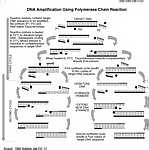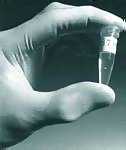|
||
 |
|||||
The Limits to Labellingby Helen Parkes Genetically modified (GM) foods are currently attracting significant media attention around the world, with considerable debate focusing on the issues surrounding the introduction of GM soya and maize.
For a food product containing soya or maize to be exempt from labelling, or to be labelled 'does not contain GM material', the retailer or supplier would therefore have to be assured that it does not contain GM protein or DNA. The challenge now facing laboratories is to provide valid analytical data on the presence or absence of GM residues in a wide variety of raw and processed foods. Detecting GM foods Labelling regulations for detecting GM organisms require testing for the presence of either the genetically modified protein or DNA. When an organism is genetically modified, it means that a fragment of 'foreign' DNA is introduced, that manufactures a protein not normally produced by that species. Protein-based methods of detection involve antibodies or enzymes, that detect either the newly-introduced protein, or its by-products. These methods have significant limitations and are not routinely employed by most laboratories for GM food detection. DNA-based methods use the newly-introduced 'foreign' DNA as a 'tag' or marker for detecting a GM product. DNA methods In a GM organism, there are usually several DNA markers that can be used for this detection:
DNA-based methods are the most reliable for identifying genetic modifications, and are the most widely used by analysts. The first step in the procedure involves extracting DNA from the food sample. Some foods, such as tomato puree, are particularly challenging, and may require optimised purification procedures to extract DNA that can be analysed.
Looking ahead But in the future, it is likely that the use of these markers may be discontinued as researchers begin to use the plant's own regulatory sequences to control the production of proteins by introduced DNA. Similarly, pressure on companies to replace or delete genes conferring antibiotic resistance, will reduce the utility of now widely employed markers. Therefore, to maintain the validity of GM food-testing, the methodology used for detection must continually match the new generation of markers. Further, when carrying out tests for GM foods it is important that we minimise the potential for false positive or false negative results. DNA is a remarkable stable molecule and often survives food manufacturing processes; hence it can be detected not only in raw foods, but even in cooked and processed products. PCR has been successfully applied to analyse a wide variety of foods from tomato ketchup, powdered soups, to rice and flour (maize and soya), and processed meat products as well. For some foods, additional analyses may be required to detect trace amounts of GM material.
In foods such as refined sugars or oils, DNA detection methods are not applicable, as in the course of food production and/or processing, plant DNA is completely separated or destroyed. Experience shows that GM maize can be identified in samples from some sources but not others, presumably due to differences in processing. A number of common food components may also limit GM detection and lead to false negative results, as they inhibit the PCR reaction and reduce the efficiency of the amplification pocess. These include calcium, iron and trace heavy metals, carbohydrates, tannins, phenolics, and salts, for example NaCl, nitrites. It is sometimes possible to overcome these inhibitory effects by modifying the PCR procedure. Many foods that may need to be labelled will be subject to varying degrees of processing, frequently with the addition of ingredients, resulting in a complex food matrix. Determining whether processed food contains GM source ingredients should ideally be done on a case-by-case basis. However, given the variety and complexity of foods available in today's markets, this would be very expensive and time consuming. Instead testing for genetic modification in the source material or raw ingredients would be a more reliable option, as long as we can ensure absolute 'traceability' of ingredients during food preparation. In this way, we could assess a wide range of related products from a smaller range of initial ingredients, saving time and money. In
common with other food labelling regulations a de minimis threshold
has been proposed for labelling GM foods, to allow for the adventitious
'contamination' of food products or ingredients in the food supply chain. Method Sensitivity Precise and accurate quantitation of the amount of GM material in any given sample is analytically very demanding, but would be required to enforce labelling regulations. Experiments show that, using standard PCR methodology, the limit of detection for GM soya flour mixed with non-GM flour is 0.1 per cent level of GM soya flour DNA, although this can be increased to 0.01 per cent by increasing the extent of PCR amplification. Labelling regulations might stipulate, for example, that only foods containing above a threshold of around 2 per cent of GM material require labelling. A value of around 1.5 per cent would be below the threshold value for labelling. Precision and Accuracy Currently, analytical methods for detecting GM food are essentially semi-quantitative, and largely based on limits of detection compared with reference standards. More accurate methods for quantifying GM material in foods are being developed (such as 'competitive' PCR, which monitors the amplification of the GM target fragment against an internal reference target, and real-time amplification to monitor the progress of PCR). The new EU regulations stipulate food product labelling if the food is derived from GM soya or maize, except when neither protein nor DNA resulting from the genetic modification is present. Analytical results demonstrate the absence of detectable DNA - that is DNA which may be present, but may not be efficiently amplified. The European Commission has debated whether highly refined products originally derived from GM ingredients, for example soya oil, would be placed on a '[GM] negative list'. Some highly processed foods constitute a 'grey area', GM DNA may be present, but may not be detectable. To be accurate, we should really replace the label 'does not contain/GM free' on certain highly processed foods by 'cannot be detected and/or quantified using routinely available technology'. This article was published in the February 2001 issue of "Keemat," the newsletter of the Consumer Guidance Society of India (CGSI) and is being reprinted here with permission. The author leads lifesciences researchers in U.K. Courtesy: Chemistry in Britain, May 1999
|
![]()
Download the free Adobe Acrobat Reader to view files in Portable
Document Format (pdf).
Copyright © 2001 Making India Green. All Rights Reserved
Disclaimer:
All content on this site is solely for the purpose of information,
and is not an endorsement of products or services provided by external links.
Partner Sites
Natural, Herbal Health
Products
Indian Parenting Blog
Beach Holiday Blog



 Although
PCR is a potentially powerful detection assay for the rapid, sensitive
and specific identification of GM foods, food processing can significantly
influence the validity of the PCR assay. Various chemical, physical
and enzymatic factors contribute to DNA degradation in processed foods.
Although
PCR is a potentially powerful detection assay for the rapid, sensitive
and specific identification of GM foods, food processing can significantly
influence the validity of the PCR assay. Various chemical, physical
and enzymatic factors contribute to DNA degradation in processed foods.








